Student Life Centre
Waterloo Undergraduate Student Association (WUSA)
200 University Avenue West, Waterloo, Ontario, N2L 3G1
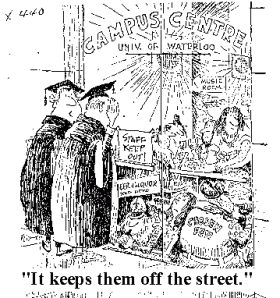 Coming to the University of Waterloo for the first time many people are struck by the sheer magnitude of the campus. Initially, it seems amazing that every discipline has it's own building dedicated to that field of study. Unique among all of the buildings at the University of Waterloo is the Student Life Centre. The sole purpose of the SLC is to be the living room of the University of Waterloo's 25,000 or so students.
Coming to the University of Waterloo for the first time many people are struck by the sheer magnitude of the campus. Initially, it seems amazing that every discipline has it's own building dedicated to that field of study. Unique among all of the buildings at the University of Waterloo is the Student Life Centre. The sole purpose of the SLC is to be the living room of the University of Waterloo's 25,000 or so students.
Open 24 hours a day, 365 days a year, and filled with comfortable couches and chairs the Student Life Centre has become a second home to generations of students. The Student Life Centre (originally the Campus Centre) was built as a meeting spot for faculty, students and staff, and has been the stage of disputes, celebrations, confusion and general anarchy. The Student Life Centre is home to the Federation of Students, and the Imprint student newspaper (the progeny of the famed Chevron), the Women's Centre (the spelling varies with the political breeze), W-PIRG (the Waterloo Public Interest Research Group), and a plethora of Student Clubs.
Taken together, all of these different student organizations have kept campus hopping. Over its' 25 years or so the Campus Centre has seen a lot come and go. At times a hot bed of student radicalism, then a hangout for "dropouts and less desirables", a midnight study lounge, or a coffeehouse, the Campus Centre has become the focal point of the University of Waterloo community.
The University of Waterloo emerged from relative obscurity 40 years ago to become a world leader in mathematics, computer science, psychology, engineering and a host of other disciplines. With a reputation built on an active, outspoken student population and, for the times, an original co-op program it's not surprising that the University of Waterloo has long been synonymous with innovation and daring.
Despite all of the advances at University of Waterloo, there have been dozens of conflicts. Even before its opening in 1969, the Campus Centre became the focus of the University of Waterloo's student protests and clashes with the University administration.
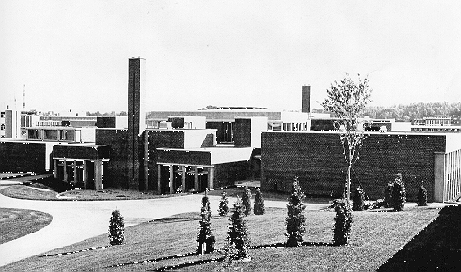
The Campus Centre in 1961.
The idea for the building on campus for student use came in 1960. To raise the necessary funds for the building students began to levy a $10 tuition fee. By 1962 students had raised over $29,000 but there seemed little hope of attaining the full amount needed to pay for the entire construction. The university promised to take over construction, but by 1966 students still didn't have their building and it didn't seem likely they'd get one. The students demanded the university return the payment of their $29,000 with interest to form the basis of a student fund. The idea was to ask for donations from local business and alumni instead of having to rely on the University. The Tenth Anniversary of the University was approaching however, and the "administration and the Board of governors realized if students knocked on corporations doors one month and got $25,000 donation, it would be highly unlikely the university could arrive the next month with it's hand out for $100,000" 1 .
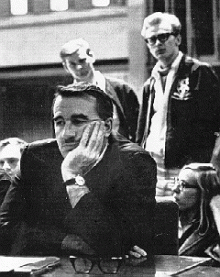
In July of that year, the University began construction of the Campus Centre. By 1968 the Campus Centre had officially opened.
The troubles were only beginning, though.
In a moment of anger the University appointed manager of the Campus Centre commented that the Campus Centre was his to run, and not the students'. In a "symbolic act of defiance" the students liberated the Campus Centre. The next day the manager found his entire office suite moved out of his office and into the centre of "his building's" Great Hall.2 The end result was a series of clashes and meetings with the university over who would control the day-to-day operations of the C.C.
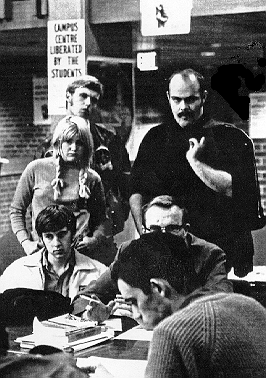 Originally designed as a place where students, faculty and staff could relax and socialize, the Campus Centre fell almost immediately into disrepute among the respectable elements of the University of Waterloo community. The Campus Centre soon became known as a gathering point for various "fringe elements", and "undesirables". The K-W police raided the building and arrested students on drug related charges. The local media became concerned about the threats the building posed for attracting bikers and other persona non grata. The Globe & Mail picked up the story and wrote a piece condemning the Campus Centre as heroine junkie haven.
Originally designed as a place where students, faculty and staff could relax and socialize, the Campus Centre fell almost immediately into disrepute among the respectable elements of the University of Waterloo community. The Campus Centre soon became known as a gathering point for various "fringe elements", and "undesirables". The K-W police raided the building and arrested students on drug related charges. The local media became concerned about the threats the building posed for attracting bikers and other persona non grata. The Globe & Mail picked up the story and wrote a piece condemning the Campus Centre as heroine junkie haven.
Just when this reefer madness had hit it's absurd high and could seemingly go no further the Chevron came in to set the record straight. The forerunner to the student newspaper Imprint, the Chevron took aim at the conservative Globe and fired with both barrels. The result was a full page Chevron spoof of the Globe's front cover. "The Boob & Tail" satire of the Globe's ultra-conservative views earned the Chevron the reputation as the best and most outspoken student newspaper in Canada.
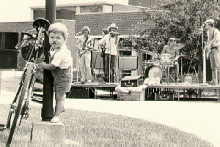 One of the main theme's of the Chevron was the student community at Waterloo. There was none of the current talk of students as clients or customers. Students were challenged to take responsibility for their community at University, as well as prepare for their future. After many debates and false starts the Campus Centre became one of the only student unions in North America to be open 24 hours a day, 365 days a year. Students were given access to study rooms, games, magazines and the like by the Turnkeys, the name given to students working part-time for the Campus Centre. For the almost thirty years continuously the Turnkeys have watched over the Campus Centre, and kept the coffee brewing.
One of the main theme's of the Chevron was the student community at Waterloo. There was none of the current talk of students as clients or customers. Students were challenged to take responsibility for their community at University, as well as prepare for their future. After many debates and false starts the Campus Centre became one of the only student unions in North America to be open 24 hours a day, 365 days a year. Students were given access to study rooms, games, magazines and the like by the Turnkeys, the name given to students working part-time for the Campus Centre. For the almost thirty years continuously the Turnkeys have watched over the Campus Centre, and kept the coffee brewing.
Over the years there have been a variety of services and movements through the C.C. The Rap Room was opened a year after the building itself to give students a more informal alternative to the University counseling department. Student volunteers were willing to talk with any staff, student, or faculty about academic concerns or personal matters. 3 The HI-line (Help Immediately) was also always available to students to call if needed to talk. Rumour has it that the rap room student attendants became so proficient with handling 'bad trips' that they were often called by local hospitals to give advice and training.
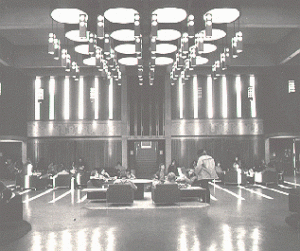 There was some debate by the Campus Centre Board, a board of directors for the Campus Centre comprised of both faculty and students, as to whether local high school students should be allowed in the building. It was agreed that the Campus Centre should not be closed to some, while opened for others who may be considered more desirable.
There was some debate by the Campus Centre Board, a board of directors for the Campus Centre comprised of both faculty and students, as to whether local high school students should be allowed in the building. It was agreed that the Campus Centre should not be closed to some, while opened for others who may be considered more desirable.
The idea of installing prophylactic vending machines in the Campus Centre's washrooms also caused a stir. The year before, when Village warden Ron Eydt requested the machines for the villages, he was refused by university president Gerry Hagey. During a C.C. Board meeting, Board chairman and History Professor Johnson, read a letter from a distributing firm requesting permission to install the machines. Before discussion could even begin, however, operations vice-president Al Adington of the Board, took the letter from Johnson's hand and claimed that the Board "cannot make that decision".4
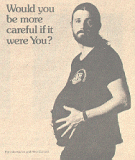 The 1970's free love and peace movement matured at Waterloo with the opening of an experimental day care centre in the C.C.5 The Waterloo Baby Commune began with the volunteer efforts of students, contributing their time and labour to the project. Though it was considered a fine temporary addition to the student services at the Campus Centre there was some concern about the University's liability.
The 1970's free love and peace movement matured at Waterloo with the opening of an experimental day care centre in the C.C.5 The Waterloo Baby Commune began with the volunteer efforts of students, contributing their time and labour to the project. Though it was considered a fine temporary addition to the student services at the Campus Centre there was some concern about the University's liability.
The other basic instincts of the student had also to be attended to. When the Campus Centre coffee shop was closed for a month between terms over 100 students and faculty signed a petition requesting the shop to be left open. When no response was forthcoming, chemistry grad student David Rees-Thomas took the operation upon himself. Operation Liberation Lunch was born from a crusty loaf, sliced meet and Baden cheese. Volunteer shoppers supplied the goods for 50 cent sandwiches --much lower than food services' going rate. The non-profit enterprise soon began to make money. The Campus Centre Board approved, and Liberation Lunch continued on into the new school term. "But I'm not a socialist" David Rees-Thomas was heard to say. "All I wanted was a decent lunch in the Campus Centre."6

After a year of fighting with the faculty association over control of the Campus Centre professor Johnson and colleague Pim Fitzgerald resigned their positions on the C.C. Board. In his letter of resignation to the Board Fitzgerald concluded:
Since the faculty association and the advocates of faculty power seem determined to destroy the avowed principle of the Campus Centre Board; ie. to attempt to create a community out of our fragmented university, and since they have reiterated their position that they believe as chairman, I have the power and the influence to introduce and enforce their faculty power policies, I have no choice but to resign. 7
Shortly afterwards the Faculty Association also withdrew from the C.C. Board until such time as more cooperative situation could be found.
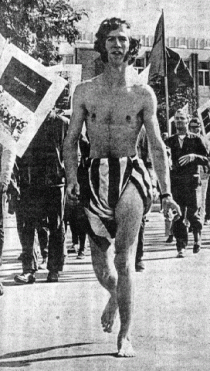
Shane Roberts joined the march clad only in this American flag. He took it off and burned it outside the Campus Centre, saying that in Vietnam more than flags were burned. (From the Chevron)
Nader is famous for his anti-corporatist works, he convincingly argued that corporations have little liability, a problem worsened by environmental pollution that does not immediately cause harm but which works over a long period of time. "The victims [of corporate pollution]", Nader was quoted as saying,
"have no say in what is going on. Only a dictatorship has that kind of power, but corporate executives prance around like pillars of the community"
Corporations are waging chemical and biological warfare against people every day, by using air and waterways as their private sewer."
Ralph Nader proclaimed at his lecture at the University of Waterloo, in late 1972.
Nader's answer was not political pressure but a combination of legal changes, education and consumer awareness. Under his influence students at Waterloo began O-PIRG (Ontario Public Interest Research Group) which circulated petitions for student support and a minimal fee to promote awareness and research into activist issues. (See Chaos cartoon!!)8
The year after the Waterloo PIRG was formed the students elected Andy Telegdi to President of the Federation of Students. "Make no mistake," Andy wrote in the Chevron, "the federation requires a great deal of hard work.... Remember the federation has a budget of close to a quarter of a million dollars. We should expect, not just expect but demand that the money be handled competently. This I intend to do. The Federation isn't little league any more. The presidency is a full time job and I intend to treat it as such."9

Andy Telegdi, President of the Federation of Students 1973-4. Andrew Telegdi, Member of Parliament 1993-7.
Telegdi left the University of Waterloo to serve on a variety of local boards and organizations. Somewhere during that time Andy got a haircut and ran for the liberal seat in Waterloo. The first University of Waterloo alumni to serve as a Member of Parliament, Telegdi was elected in 1993, with University of Waterloo history professor John English.
Around the same time Eby Town Food Co-op got its start. The mission of the organization is to provide healthy, organic food as an alternative to the processed food in the regional stores. The campus radio station also had its start near this time. A full time manager was hired for a brief period to organize the station and the volunteers. Different permanent managers are still on staff, making sure that CKMS remains one of the highest quality non-commercial volunteer stations in Canada!
When not concerned with academics, political issues, women's rights, ecology, corporations, and a host of other things,the University of Waterloo students have been known to cut loose in many different ways. Student clubs, rock concerts and special events make up just some of the more popular past times. (the PAC building has played host to the Band and Led Zeppelin and many other big names at the time.)
Throughout war protests, parties, sit-ins and blow-outs has been the Campus Centre. Over the years the building has seen a lot of changes, and in the years to come will, no doubt, see many more. As always, what remains is ... to be continued.
Concordia Cum Veritate
In Harmony With Truth

(or: A Compromise With Reality)
The University of Waterloo acknowledges that much of our work takes place on the traditional territory of the Neutral, Anishinaabeg, and Haudenosaunee peoples. Our main campus is situated on the Haldimand Tract, the land granted to the Six Nations that includes six miles on each side of the Grand River. Our active work toward reconciliation takes place across our campuses through research, learning, teaching, and community building, and is co-ordinated within the Office of Indigenous Relations.